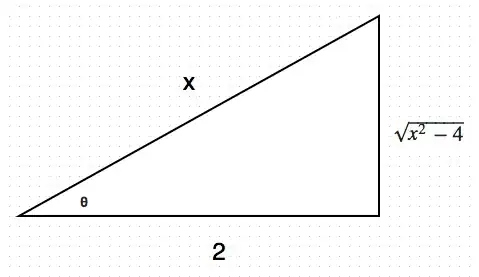I think the way to think about trigonometric substitutions is to remember the fundamental result that
$$\sin^2a + \cos^2a = 1$$
for any angle $a$. So, in your example, you have a square-root
$$\sqrt{x^2 - 4}$$
Imagine for a moment that that 4 was a 1 and that they were reversed, like so:
$$\sqrt{1 - x^2}$$
Then the substitution $x = \sin\theta$ would result in something simple, without the square-root, namely
$$\sqrt{1 - x^2} = \sqrt{1 - \sin^2\theta} = \cos\theta$$
That's the gist behind trig substitutions.
Now, in your case in particular, things aren't so simple so let's work it out step by step. First, imagine the 4 is a 1:
$$\sqrt{x^2 - 1}$$
We can't use $x = \sin\theta$, nor $x = \cos\theta$, here because we'd get the square-root of a negative quantity. For instance, using $x = \sin\theta$,
$$\sqrt{x^2 - 1} = \sqrt{-\cos^2\theta}$$
So how can we use the fundamental relation at the top of this post to get something like $x^2 - 1$? Well, divide both sides by $\cos^2a$ and write it as follows:
$$\frac{\sin^2a}{\cos^2a} + \frac{\cos^2a}{\cos^2a} = \frac{1}{\cos^2a} \quad \rightarrow \quad \tan^2a = \frac{1}{\cos^2a} - 1 = \sec^2a - 1$$
Now it's obvious that $x = \sec\theta$ give us
$$\sqrt{x^2 - 1} = \sqrt{\sec^2\theta - 1} = \sqrt{\tan^2\theta} = \tan\theta$$
and we once again got rid of the square-root. The only thing that remains is the 4. We can deal with that by scaling. Choose $x = 2\sec\theta$, instead, so
$$\sqrt{x^2 - 4} = \sqrt{4\sec^2\theta - 4} = \sqrt{4(\sec^2\theta - 1)} = \sqrt{4\tan^2\theta} = 2\tan\theta$$
So, to summarise, all you really need to remember is the fundamental relation at the top of this post and "massage" it as necessary to get rid of any square-roots that are in your way.
The two main forms that you'll use are:
$$\sin^2a + \cos^2a = 1$$
and
$$\tan^2a + 1 = \sec^2a$$
which, as we've seen, are really one and the same.
